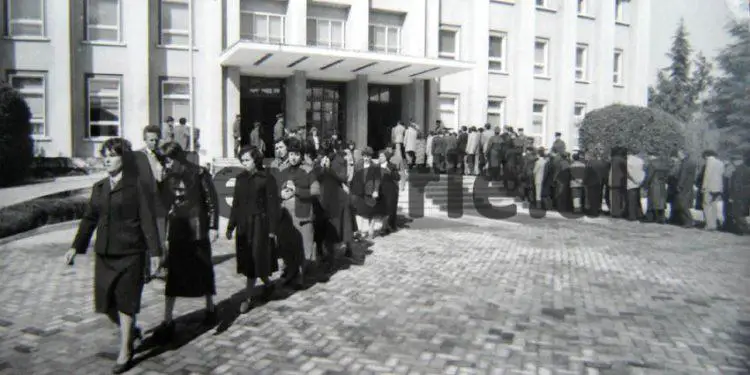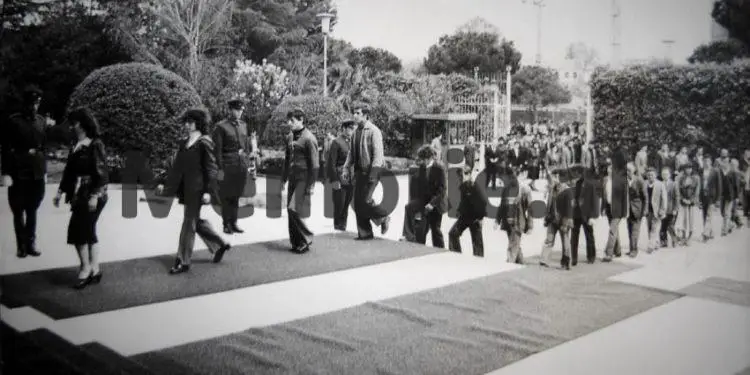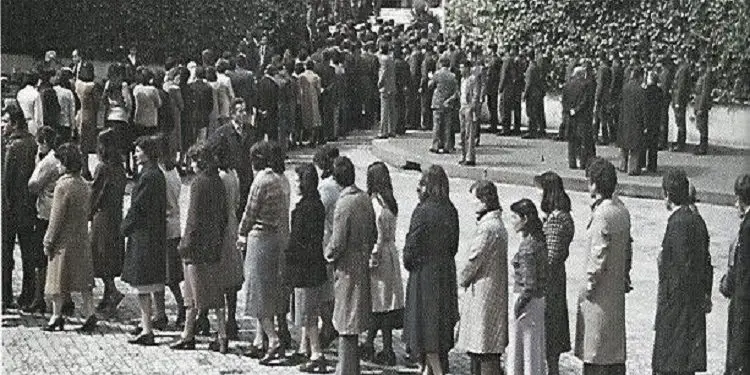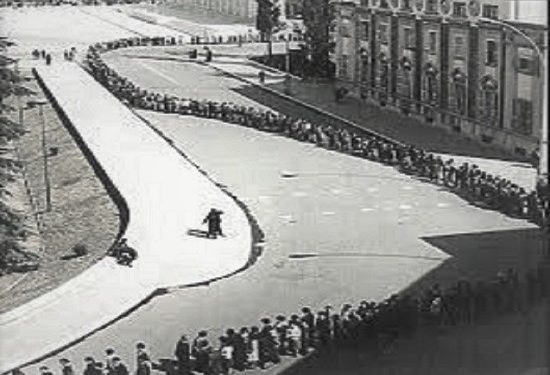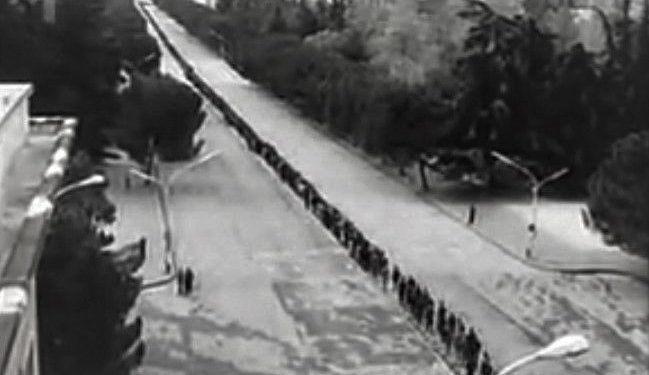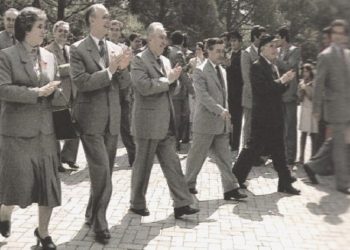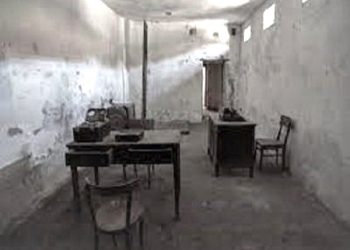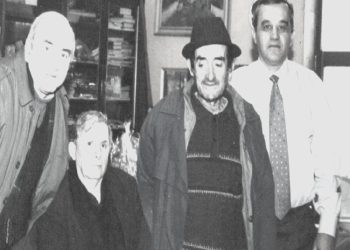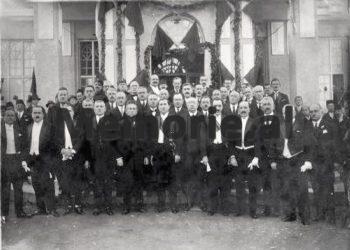By Vasil Qesari
Memorie.al/ The overthrow of the great totalitarian edifice in Albania would leave behind, not only the change of the system, accompanied by full hopes, mirages and cries of happiness but, unfortunately, also many wounds, dramas, victims, dust, ml lefe and disappointments from the most diverse. Ten years and more after that event, which deeply shook society, completely overturning many previous codes, rules and concepts, people still continue to ask themselves such questions as: What really happened in society Albanian, during the last 50 years of the dictatorship? How was it possible that the system managed to warp everything? Why did people accept it? What was the totalitarian logic of the transformation of society and the individual? How were the structures of totalitarian mechanisms conceived and functioning: propaganda, secret police and the exercise of the ideology of terror? How did it happen that among all the communist countries of Eastern Europe, Albania was considered an exception or a special case? Why did Enver Hoxha remain blindly, fanatically loyal to Stalin until the end, turning the country into a prison where violence, fear and purges continued until the end of the 80s? Why was the country so insanely isolated, locking people up between bunkers and barbed wire? Why, then, did all the above phenomena happen…?! The book “Post-scriptum for Dictatorship” does not claim to provide definitive answers to the above questions, or the complexity of the reasons that brought and maintained the totalitarian power in Albania. Nor is it a complete, deep and comprehensive fresco of the life and suffering that people experienced during that system. Its author, perhaps, has the merit that together with the retrospective view of the totalitarian period as well as the zeal of a passionate analyst, he has tried to turn his head back once again, to give not only his personal memories and opinions, but also to return once again to the vision of that era with the simple philosophy of preserving the Memory and supporting the Appeal to never forget the well-known maxim, that…the corpse’s nails and hair continue to grow even after death! Ten years or more after the great revolution, the book in question has current value and we hope it will be appreciated by the reader because, as an Albanian researcher also says… the greatest evil that can happen to a people comes when he fails to analyze his own past. An amnesic people are forced to be constantly neuropathic and repeat their painful experiences…!
THE OLD WOUND OF THE “TIGER”
November 7, 1984
In front of the bust of V.I.Lenin, in the square of the Cement Factory of the same name, two or three hundred people had gathered. The 67th anniversary of the October Socialist Revolution in Russia was commemorated. The first secretary of the district Party committee, Enver Halili, began to speak about the faithful continuation of the ideals of that revolution and the ALP led by the outstanding Marxist-Leninist of the modern era, Enver Hoxha. After a while, from among the gray ranks of workers someone threw up a banner, cheering as loudly as they could. For a moment, the crowd seemed to be shaken from a deep sleep. The workers, like clay statues covered in a cloud of cement dust, moved from the site. Then, when the main speaker, amplified by several loudspeakers, spoke the name of the commander, a group of militants who had taken a seat in the first row, started the well-known song: “Enver Hoxha, o long life”! From the podium, the first secretary continued:
– “Our sworn enemies, internal and external, deliberately spread the word that our glorious leader Enver Hoxha is sick…”!
– “To take the evil from us! – a voice was heard from the group of militants”.
“So, happy mouth…”! – Some others approved. “But Comrade Enver Hoxha, like our people, is immortal! – continued the first secretary – He is healthy and red as an apple”!
It was the first time that, with preconceived intentions, the taboo subject of Enver Hoxha’s health was discussed publicly. Well, not only in Vlora, but everywhere. In each district, the first secretaries were instructed to, in meetings with the people; highlight his excellent state of health, but without even making another comment.
(Actually, the action in question, among others, was the response to a news that Italian television had given a few days ago, in which it was said that, according to some unconfirmed sources, Enver Hoxha, the leader of Albania – the bastion the last Stalinist in Europe – he is either dead or in the last throes of a long and incurable illness, and this has not been made known to the people).
After that chilling news, evil mouths had begun to whisper that His days were numbered. There was even word that a prominent Japanese professor had come to Tirana on a special plane to examine his serious condition. Indeed, despite all the extraordinary conspiracy, the words had not come out in vain. In fact, Enver Hoxha, you had very little left to live. Only a few months ago, on the evening of February 16, 1984, during a meeting with the secretaries of the Central Committee of the Party, he left the hall holding his arms and dragging his feet. Then, that same dinner, he was hit hard by another heart attack. Alarmed, Nexhmija had urgently called the doctors, along with them and Ramiz Ali. The next day, the latter hastily convened the Political Bureau, to inform it about the situation.
But the “tiger wound” was already very deep and old.
It appeared for the first time as early as 1948, during a family celebration organized on the occasion of the New Year. It was exactly then that the first signs of diabetes appeared to Enver Hoxha. From then on, he would never enjoy good health. After the examinations, the doctors recommended that he take more care and, especially, maintain a diet. But the problem was not so easy. Enver Hoxha was a great joy to raise. Especially, when it came to the French menu, which was prepared by a chef who had lived in Lyon for many years. Without speaking then, about the various cheeses that came to him by way of diplomatic suitcases.
Years passed…!
The young and azgan man, the 53-year-old patriarch Enver Hoxha, spends his life between his office, library, the real “castle” of power, and a string of villas scattered across the four corners of the country. But, despite his imposing appearance, he does not enjoy the health he presents. Even after Nexhmija’s numerous and persistent interventions, he can’t stop smoking. To make matters worse, he continues to avoid heavy meals, while being diabetic, he is forced to follow a very strict diet…! In the spring of 1966, Enveri fell ill again. Now, apart from diabetes, other problems of a cardiac nature have arisen. The doctors advise him to relax, to do without rest. After two years, at about the same time, he becomes ill again. This time, the doctors order him to change the climate and go on vacation to Vlora.
1969, March
Enver Hoxha rests in Cold Water. The Mediterranean climate, it seems, does them well. However, the road from the edge of the sea to his villa is very tiring. On summer days, he cannot go down to the beach to take a bath. Then, Nexhmija suggests that a swimming pool be built next to the villa. For the realization of that idea, Hysni Kapo and Ramiz Alia are especially committed. The pool, under the supervision of the soldiers of the Security Guard, is built in record time. Within 10 days. (While he was visiting his hometown). When he returns from Gjirokastra, Enveri looks at the pool in surprise and shouts with tears in his eyes full of excitement: Long live the Party!
Year 1970
It is the period of the first Albanian-Chinese frictions. Worries mount. Even during that year, Enver Hoxha’s condition continued to deteriorate. As a result of diabetes, the vision weakens more and the difficulties for reading newspapers, news bulletins and books increase. Doctors order outside, special new technology glasses, but without success. Then, it is decided that a member of the secretariat will go to his house for a day and read the necessary materials. But it seems that Enver does not like this. Then only one solution remains. Abroad, a projector equipped with an image enlarger is ordered. Thus, writings and articles are cut by his assistant and placed on the magnifying device. It seems that, like this, Enveri can read…!
In 1973, the unexpected happened!
For the first time, he suffers a serious myocardial infarction. (At the same time, more and more, the signs of the mania of persecution also appear openly. He sees enemies and only enemies around him). October 1973. Enver Hoxha celebrates his 65th birthday. Only a few hours, after the ceremony organized for that occasion, he falls to the ground, hit by a new cardiac crisis stronger than the first. The doctors, led by the well-known professor Petrit G, recommend absolute rest again. Meanwhile, Nexhmija gives a firm order: “…For the new heart attack, only the family and friends of the Political Bureau should be informed. The others should not know anything, because, on the one hand, we do not want to grieve the hearts of the Party members and the people, and, on the other hand, we do not want to give the enemies an opportunity to rub their hands in joy… “!
Year 1976
His vision problem is becoming more and more disturbing. He is almost blinded. Then, a tape recorder is ordered outside, with which he dictates orders, orders, instructions or parts from the Memories. The recorded tapes are then scanned by his personal typist.
Year 1979, April
The sick “old man” is struck again in the heart. He is now unable to read with a magnifying glass or with a magnifying projector. During short walks in the villas of Vlora or Pogradec, he regularly carries a cane. The direction of the Party is actually taken over by Nexhmija. She is the one who, among other things, reads for days the telexes of the Albanian embassies or the notes kept from the meetings of the Central Committee. During his rare public appearances, hiding his true state of health becomes more and more difficult. Thus, during the proceedings of the VIIIth Congress (1981), Enver Hoxha appeared on the podium as a candle doll, with a frozen smile and very thick glasses. He barely pronounces only the first sentences of the report, and then continues his reading recorded on the tape recorder.
December 1981
Mehmet Shehu kills himself. “The wound of the tiger” sheds the last spurts of blood. But, nevertheless, the people and the enemies of Albania must make sure that he is there. Always alive and immortal. With the sword drawn to strike the enemies. Thus, his appearance in public is improvised, carefully and according to the well-known Stalinist style. Right at the National Exhibition of Fine Arts. But, in the television chronicle of the Evening News, despite all the editing tricks, miracles are not possible. On the screen, the ghost Enver appears. Pale, wasted and with a haunted look. Sitting on the couch. After that exit, he will reappear again, on July 7, 1983. This time, at the “Qemal Stafa” stadium, on the occasion of the 40th anniversary of the founding of the Army. Again, frozen as a statue and not saying half a word. On November 28, Enver Hoxha participates in the military parade organized on the occasion of the 40th anniversary of the liberation. It is also his last appearance in public. Weak, wasted and with a face that doesn’t look like him. With one arm paralyzed and, with the right eye, frozen by cerebral ischemia. Since he is unable to speak, his message to the people is through radio and television. It is also his message – his testament: “…For us, soldiers of the Party, there is no greater joy than when we see that our people are masters of their own destinies, happy, happy and free in sovereign Albania. In Albania transformed into an invincible fortress, which tirelessly walks the path of building socialism…”!
The “old tiger” has come to an end…!
The white crest of hair hangs over her neck like a wig. Now, he is nothing more than a rotting corpse in the grave. Yet the Party, desperate but stoic, tries to keep quiet about his health. Meanwhile, the Albanians still do not know that their glorious commander now moves on a wheelchair with wheels and mocks the soldiers of the guard, cursing them with all kinds of dirty words.
April 9, 1985
Around 09:30 in the morning, the beast finally bursts to the ground. With convulsions. Breathless. Mouth full of drool and foam. He thus received the last blow to the heart. No medical intervention can bring him back to life…!
THE DEATH OF THE “SULTAN”
Would the cataclysm really happen, when Enver Hoxha would die?! Was he a mortal being like all the others, while many Albanians considered him eternal, like the gods of Olympus? After all, could he die, who had become a symbol of Albania? The one whose name was sung, glorified, hymned and raised to heaven, for every day? In public, private parties, at birth, death and marriage?
On April 11, 1985, at the Party Committee in Vlora, the lights were on since dawn. The high cadres of the Party, the police state, came and went in cars that drove at high speed. At 07:00, the first secretary urgently called a meeting of the apparatus. Deathly silence reigned in the packed hall. The first secretary, dressed in a black suit, with bruised circles around his eyes, with a trembling voice and broken sentences from emotion, gave the terrible news:
On April 11, 1985, at 2:15 in the morning, the heart of the beloved and glorious leader of the Party and our people, Comrade Enver Hoxha, stopped beating. Some women screamed louder, while the men groaned deeply and took out their handkerchiefs. Then, there was confusion and chaos in the hall, but the secretary calmed down and continued reading the Communiqué of the Central Committee of the ALP and the Medical Bulletin, signed by 8 doctors. In it, it was said that the death had occurred after:…several strong lesions of the peripheral collateral system and damage to the heart, kidney and other organs. Already in 1973, Enver Hoxha had suffered a myocardial infarction accompanied by heart arrhythmia. In the following years, a severe coronary insufficiency developed which, a year ago, became the cause of a stroke from cerebral ischemia. On the morning of April 9, unexpectedly, his heart stopped beating due to ventricular infiltrations. The death of Enver Hoxha was accompanied by unprecedented tension and alarm in the entire leadership of the Party. But, for two days in a row, it was kept secret and a big secret. Why?! Undoubtedly, for the organization of the Great Spectacle of tributes, the burial, the appointment of his deputy as well as the drafting of the succession strategy. To ordinary people, who were used to the idea that the legendary commander was immortal, the sudden news caused shock, confusion, bewilderment and numbness.
(However, those who thought that his death would mark the end of the world saw with surprise that life continued as before and that the sun rose again. While others, who had been waiting for years and years impatiently for the end his, were more or less convinced that the disappearance of Enver Hoxha was also the end of an era which, unfortunately, had been the blackest in its modern history). Despite all the confusion, the Party leadership quickly set to work to establish the cult of Immortality. The mobilization of propaganda, press and radio-television with the main slogan Let’s turn pain into strength, was aimed not only at further strengthening of unity, but especially at the eternal preservation of the Icon. So, the Messiah was really dead, but the icon would continue to be present everywhere. Imposing, authoritative and especially scary and threatening, at every moment she had to remind people that nothing had changed. That Enver Hoxha was alive and immortal and that those who thought differently would be brutally punished as before…
Official funerals were scheduled for April 15. The coffin was placed in the lobby of the People’s Assembly building. The television broadcast scenes from the tributes for the night. View of hysteria. Tears, screams and tears. Throughout the country, there was an unbridled competition for writing telegrams, letters, messages, rhapsodes and poems which, then, through the Party committees in the districts, were sent to the Central Committee in Tirana. The newspaper “Voice of the People” evoked for days, the polyhedral and historical figure of the immortal leader. Those who had the great fortune to live the glorious era of Enver, – it was written, among other things, in one of her writings – will undoubtedly be among the luckiest of all generations to come. We were, we worked and lived together with him! – they will say proudly. Meanwhile, in the atmosphere of collective mourning, well-known and unknown poets and writers published prose and elegy, expressing their great sorrow for the irreplaceable loss of the most outstanding man the Albanian nation had ever born. The funeral ceremony took place on March 15. On a gloomy and rainy day. The coffin with the body was placed on a ball bed. At the front of the procession walked 14 soldiers holding red cushions with decorations in their hands. After them came the family and members of the Political Bureau. Cameras and photojournalists constantly focused on groups of people wailing and tearing their cheeks.
Then, the procession stopped, in Skenderbey Square. While his successor, Ramiz Alia, kept the word of the case, the television director occasionally merged with the image of the rally a film frame which, then, was described as a genius artistic find. The rain was falling on the Skanderbeg monument. Tears flowed from the eyes and chin of the national hero. Ideal, isn’t it…?! Skanderbeg was crying for the loss of his son…! The dictator’s death also provoked reactions in foreign embassies. Because, indeed, Enver Hoxha was in charge of an extreme and bloody regime, but that was only one side of the coin. On the other hand, there were geopolitical interests, which for the West had special importance. Ultimately, the West could not forget that Enver Hoxha was the one who broke away from the Soviet Union and removed from his country the entire arsenal of nuclear missiles directed from the Old Continent.
For this, he was definitely rewarded.
The West and its secret services had finally deleted Albania from their Cold War plans, keeping around it an indifference and total silence, almost as if it did not exist at all. The dictator was thus left with free hands to quietly continue his crimes. In this way, without even the slightest hint of conscience, even with full consciousness, the West had contributed to and legislated with cynicism the bloodshed and tragedy of an entire people. However, in the outside world, contrary to what was thought inside the country, the echo of Enver Hoxha’s death was very small. According to the French newspaper Le Monde of April 13, 1995…the death of Hoxha has caused few official comments in the big European capitals, which have generally been content with sending short messages of condolence to the leaders of Tirana. The Greek Prime Minister Mr. Papandreou, who recently influenced the development of economic relations with Albania, has expressed his “bitterness”. Likewise, the French Communist Party also announced the sending of a consoling message. In Washington, the State Department announced that the US was ready to resume a fraternal dialogue with Albania, if the latter would request it…!
Meanwhile, on April 12, in the 20:00 edition, Italian television gave a short news story accompanied by images, where the Albanian leader was described as the man who managed to bring the Albanians out of extreme misery into a dignified poverty. However, the Hsinhua news agency and the Chinese Communist Party daily “Zhenminzhibao” published the news of Enver Hoxha’s death, accompanied by a photograph of the deceased the size of a postage stamp surrounded by a black tape. From Moscow, with four lines published in the daily Pravda and the TASS news agency, the Central Committee of the Soviet Communist Party expressed its condolences to the ALP on the occasion of Hoxha’s death. The Yugoslavian press devoted something more to the event, describing it as the end of Enver Hoxha’s era. In it, his biography was briefly published, as well as the many conflicts that had characterized the relations between the two countries…!
Meanwhile, Albania was covered in mourning. Women were instructed not to wear lipstick and weddings, to postpone and do without music. After his death, the cult of the dictator became more frenetic to extreme absurdity. Thus, posthumously, the organization of pioneers, set up on the Soviet model, was called Enver’s Pioneers. After that, on the 16th of every October (which used to be his birthday) the Enver Week movement was initiated. And, within that framework, the Professional Unions (BPSH), created a special title of honor for the collectives of vanguard workers, which was called, “Flagship of the implementation of the implementation of the teachings of Comrade Enver”. In every part of the country, in cities and villages, in every school, factory, square and neighborhood, so-called Enver’s Corners began to appear. They were also the places where the Holy Icon would be placed. The regime was thus raising the totems of the New God.
Accompanied everywhere by stands, banners, photos, slogans, revolutionary initiatives and large concrete stars, which bore the inscription Enver Hoxha, 1908 – Immortal, they returned to the chapels of God Enver. But the zeal and veneration towards Zeus did not end there. Then, by a special decision of the Central Committee of the Party, Enver’s name was simultaneously given to the Fierza Hydropower Plant, the Metallurgical Combine in Elbasan, the State University of Tirana and the Tractor Plant. In 1986, by the daughter and son-in-law of Enver Hoxha, the project was drawn up, and in the center of Tirana, construction work began on the magnificent museum dedicated to the Immortal Leader. The place designated for that purpose was surrounded by walls, panels and armed soldiers. An engineer, who worked on its construction, confesses:…Why did Nexhmija prefer the construction of a museum instead of a mausoleum? Was that a “bequest” of Enver or Nexhmija’s own decision or choice? This is really a mystery. In my opinion, what had happened in the Soviet Union with the embalmed body of Stalin, no doubt they will have tempted him enough, leading him to the decision that the body of Enver Hoxha should not be embalmed…! Of course, at that time, she did not even think of the events that would happen five or six years later, but apart from a certain doubt and thanks to tradition, she judged that his body, however things would turn out, would to be more protected in the depths of the earth. Since the beginning of construction, many people, when they saw his project, called it “Pyramid”. (A name that remains to this day)
…For the December 21 construction undertaking, the facility was deemed of special importance. They worked not only during the day, but also at night under the light of projectors. For its construction, the Party did not spare millions of dollars, at a time when the country’s foreign exchange reserves were minimal. Groups of technicians and engineers were sent to various Western countries to order and buy without saving, everything that was needed for the grandeur and luxury of the “object”! But the efforts to keep Enver alive continued in vain. On October 16, 1988, with on the occasion of the 80th anniversary of his birth, three giant statues were inaugurated in Albania. One in Korça, where he appeared at a young age, when he was a professor at the French high school. The other in Tirana, in a more manly age, with an overcoat, suit and tie. And, the third, in Gjirokastër, sitting, old and meditating.
In 1991, along with the overthrow of the dictatorship, its idols, which many called eternal, collapsed. The pyramid erected in memory of the Pharaoh of Tirana, turned into a Cultural Center as a paradox of the fact that even Enver Hoxha had turned many churches and mosques into houses of culture and parties. The first object that was opened inside it was, surprisingly, a cafe which reminded people that even the owner of the house (Faraoni) had started his career as the owner of a pub, in Tirana.
…Thus, Enver Hoxha’s last life gives us the perfect example of a totalitarian tyrant as much as Stalin and Hitler. Like his beloved teacher Stalin, he died in his bed and was called immortal in life, whiles the typical totalitarian inscription, Enver Hoxha 1908 – Immortal, was placed on his grave. Then, as has usually happened with the stories of tyrants, since time immemorial, there came a day when his corpse was unburied at night and thrown into a pit in the cemetery of Sarra, without leaving a single stone. over. Finally, with complete conviction, we say that Enver Hoxha’s life as a despot fully deserves as an Epitaph, a well-known maxim of Machiavelli, in which it is said: “…They are condemned to fail with shame, curse and disgust all those people who destroy religions and overthrow states. All enemies of human talents and courage, of literature and useful arts, of values honored by human beings. So, in short, all those who, in their acts and actions, are characterized by iniquities, cruelty, violence, ignorance, baseness and vanity”. Memorie.al




